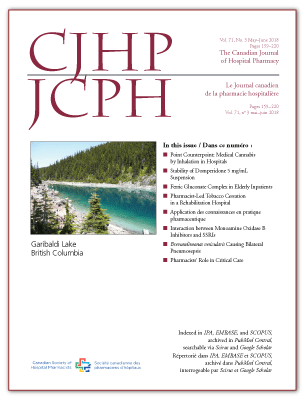Implementation of a Pharmacist-Led Inpatient Tobacco Cessation Intervention in a Rehabilitation Hospital: A Before-and-After Pilot Study
DOI:
https://doi.org/10.4212/cjhp.v71i3.2584Keywords:
smoking cessation, rehabilitation hospital, Ottawa Model for Smoking Cessation, pharmacist, désaccoutumance du tabac, centre de réadaptation, Modèle d’Ottawa pour l’abandon du tabac, pharmacienAbstract
ABSTRACT
Background: Inpatient rehabilitation presents a unique opportunity for smoking interventions, given the typical lengths of stay, the relevance of smoking to the admission diagnosis of many patients, and the occurrence of nicotine withdrawal during the hospital stay.
Objective: To evaluate the feasibility of implementing a pharmacist-led version of the Ottawa Model for Smoking Cessation (OMSC) program at a rehabilitation hospital, using the indicators of reach, effectiveness, adoption, and implementation.
Methods: A before-and-after pilot study was conducted. Smoking cessation data were collected from 2 cohorts of eligible smokers identified during 4-month periods before (control) and after (intervention) implementation of the OMSC program. Control participants received usual care (i.e., no cessation intervention). Intervention participants received initial in-hospital smoking cessation support (counselling and nicotine replacement therapy), inpatient follow-up during the hospital stay, and 3 months of postdischarge follow-up calls, with all aspects led by hospital pharmacists.
Results: Among all patients admitted to participating inpatient rehabilitation units during the 2 study periods, smoking prevalence was 7.8% (127/1626). After exclusions, deaths, and withdrawals, 111 patients were retained for analysis: 55 in the control group and 56 in the intervention group. The overall mean age of participants was 64.9 (standard deviation [SD] 14.3) years, with a mean smoking history of 35.0 (SD 24.8) pack-years. There were no significant differences between groups in terms of baseline characteristics. Self-reported abstinence rates (determined 3 months after discharge) were higher after compared with before implementation of the OMSC program: for continuous abstinence, 16/56 (28.6%) versus 9/55 (16.4%), _2 = 4.462, p = 0.035; for 7-day point prevalence abstinence, 21/56 (37.5%) versus 10/55 (18.2%), _2 = 6.807, p = 0.009.
Conclusions: Implementation of the OMSC program at a large rehabilitation hospital was feasible and led to an increase in 3-month smoking abstinence. This study provides preliminary evidence to support inclusion of smoking interventions as part of inpatient rehabilitation care.
RÉSUMÉ
Contexte : La réadaptation des patients hospitalisés représente une occasion unique de procéder à des interventions de désaccoutumance du tabac, notamment en raison de la durée habituelle des séjours, du rapport entre le tabagisme et le diagnostic posé à l’admission, et de la survenue du syndrome de sevrage de la nicotine durant le séjour.
Objectif : Étudier la possibilité de mettre en oeuvre une version dirigée par des pharmaciens du programme Modèle d’Ottawa pour l’abandon du tabac (MOAT) dans un centre de réadaptation en employant les indicateurs pour la portée, l’efficacité, l’adoption et la mise en oeuvre.
Méthodes : Une étude pilote avant-après a été menée. Des données sur la désaccoutumance ont été recueillies auprès de deux cohortes de fumeurs admissibles qui ont été repérés pendant des périodes de quatre mois avant (groupe témoin) et après (groupe expérimental) la mise en oeuvre du programme du MOAT. Les participants du groupe témoin ont reçu les soins habituels (c.-à-d. sans intervention de désaccoutumance). Les participants du groupe expérimental ont reçu un soutien initial à l’hôpital pour la désaccoutumance du tabac (des conseils et un traitement de remplacement de la nicotine), un suivi pendant le séjour à l’hôpital, et des appels de suivi pendant les trois mois suivant le congé, le tout sous la direction de pharmaciens d’hôpitaux.
Résultats : Parmi l’ensemble des patients admis dans les unités de réadaptation participantes au cours des deux périodes de l’étude, la prévalence du tabagisme était de 7,8 % (127/1626). Mis à part les exclusions, les décès et les abandons, 111 patients ont été retenus pour l’analyse : 55 dans le groupe témoin et 56 dans le groupe expérimental. L’âge moyen des participants était de 64,9 (écart-type de 14,3) ans et leur antécédent de tabagisme moyen était de 35,0 (écart-type de 24,8) paquets-années. Aucune différence significative n’a été relevée entre les groupes en ce qui touche aux caractéristiques de base. Les taux d’abstinence autodéclarée (déterminée 3 mois après le congé) étaient plus élevés après la mise en oeuvre du programme du MOAT : pour une abstinence continue, 16/56 (28,6 %) contre 9/55 (16,4 %), _2 = 4,462, p = 0,035; pour une abstinence ponctuelle de sept jours consécutifs, 21/56 (37,5 %) contre 10/55 (18,2 %), _2 = 6,807, p = 0,009.
Conclusions : La mise en oeuvre du programme du MOAT dans un important centre de réadaptation a été possible et a mené à une amélioration de l’abstinence du tabac à trois mois. Cette étude donne des résultats préliminaires en appui à l’inclusion d’interventions de désaccoutumance du tabac aux soins de réadaptation de patients hospitalisés.
Downloads
Published
Issue
Section
License
Copyright © Canadian Society of Healthcare-Systems Pharmacy.
After publication of a manuscript in the CJHP, the authors of the manuscript must obtain written permission from the CSHP (publications@cshp.ca) before reproducing any text, figures, tables, or illustrations from the work in future works of their own. If a submitted manuscript is declined for publication in the CJHP, all said rights shall revert to the authors. Please note that any forms (e.g., preprinted orders and patient intake forms) used by a specific hospital or other health care facility and included as illustrative material with a manuscript are exempt from this copyright transfer. The CJHP will require a letter from the hospital or health care facility granting permission to publish the document(s).










